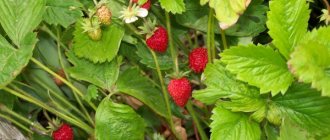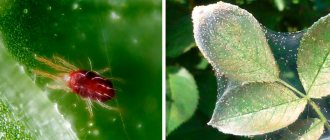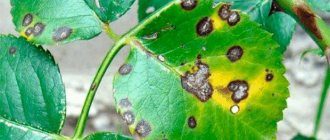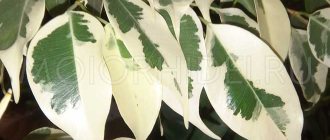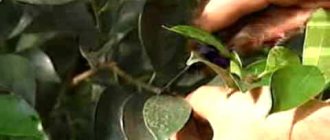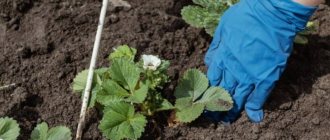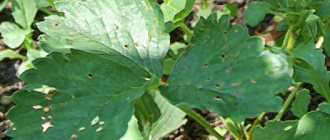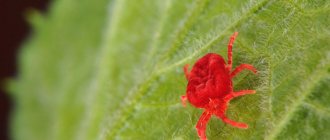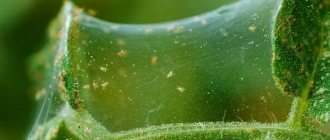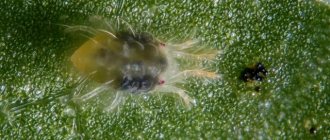You have probably encountered symptoms of strawberry mite infestation of strawberry leaves, or you simply cannot understand what happened to your strawberries, why their leaves began to become deformed (wrinkle and curl).
Read on in our article to learn how to fight strawberry mites on strawberries and what acaricidal preparations to spray strawberry bushes with.
Description of the pest
Garden strawberries are affected mainly by 2 types of mites: strawberry mites (Phytonemus pallidus), sometimes called cyclamen mites by florists, and the common spider mite (Tetranychus urticae). Fighting the latter is not much of a problem. Both specific acaricides and insectoacaricides from the organophosphorus group cope with it. The fight against strawberry is more complex, so the recommendations presented in the article are focused specifically on this type of pest.
The strawberry mite (Phytonemus pallidus) has a flattened, elongated, translucent body. Adults reach a length of about 230 microns. Due to its small size, this arthropod can only be seen through a microscope or a magnifying glass with 10x magnification.
Ticks have enormous fertility with a short period of larval growth. In one strawberry season, about five generations can appear in the beds. The peak of damage occurs at the end of summer. When the temperature drops to +10℃, the tick hides in leaf folds for the winter. Threshold of tangible economic damage from mites: 4-8 mites per leaf.
The tick feeds on plant sap and lives in the central bud—the heart. The youngest unblown leaves are affected.
Among modern varieties, Elsanta strawberry showed excellent resistance to mites
Green manure
Experienced gardeners know that some plants are very useful “neighbors” and are able to protect berry crops from various pests.
Beans
It is planted not only for harvest, but also for decorating hedges, gazebos, verandas, and also as an effective natural repellent. To protect strawberries and strawberries from mites, it is preferable to use lima beans.
Lavender
A beautiful purple plant can not only decorate the area, but also repel strawberry mites along with mosquitoes.
You need to choose not a mountain variety, but a narrow-leaved variety.
It contains a lot of essential oil, camphor, ocimene, linalool.
All these components are harmful to insects. Instead, the garden will always have a pleasant smell of flowers.
Catnip (catnip)
Catnip or, as it is popularly called, catnip, is a low plant with a pleasant, refreshing aroma.
It does not exceed 40 cm in height and has slightly spreading stems.
Its flowering occurs precisely during the period of tick activity - from mid-summer until autumn.
Pests cannot stand its smell, so they will leave the berries alone.
Tansy
An excellent alternative to pesticides is tansy.
It takes root well even in poor soil with a lot of clay; people consider it a weed due to its unpretentiousness.
The plant emits a subtle smell reminiscent of camphor, which has a depressing effect on the strawberry mite.
Tansy repels most insects including aphids, slugs, and caterpillars.
Rosemary officinalis
If the strawberry bed is located on a well-lit, flat area, you can plant additional rosemary.
It grows well in fertile soil with a neutral pH level and loves sun and warmth. During flowering, which occurs in the summer season, the plant emits an aroma that repels pests.
Unfortunately, rosemary is not able to withstand low temperatures, so it needs to be dug up for the winter.
Chamomile
Chamomile, beloved by many gardeners, is a good weapon against strawberry mites.
Its juice contains toxic compounds - cinerine and peritrin.
These two substances paralyze the muscles and nervous system of insects.
Flowering continues all summer, the plant is unpretentious to soil and care, and its flowers will delight the eye day after day.
Among flowering plants, you can plant calendula, dandelions, and marigolds next to the strawberry bed.
What harm does it cause, signs of defeat
The strawberry mite stops the growth of buds on the plant throughout the growing season. The tick is especially dangerous for adult bushes. Colonies of parasites settle on the underside of the foliage of succulent young greenery. The plant juices are drawn out, thereby depriving the bush of strength for further growth and fruiting. Pests can attack both mature bushes and new rosettes on the tendrils.
You can tell that strawberries have suffered from a mite infestation by the following signs:
- the growth of the bushes slows down greatly, then stops, the bushes become dwarf;
- young leaves began to appear in “waves” and became wrinkled and twisted;
- the leaves acquire a yellowish-oily tint and dry out at the height of the season;
- young leaves cannot open, their edges are fastened;
- on the back side of the leaf plates you can see a silvery coating;
- the fruits dry out before they have time to ripen;
- the bushes cannot tolerate winter temperatures and die.
These alarming signs on berry plantings cannot be ignored. Successfully fighting strawberry mites is not easy, but it is possible.
During processing, special attention should be paid to the center of the bush - mites primarily attack young leaves
Alternation of territory during disembarkation
There are many subtleties that are well known to experienced gardeners, and they relate to the correct planting of plants. It is recommended to alternate the area when planting strawberries. This is an important rule for growing it.
Plants can be replanted in their original place of growth 4 years after transplantation. Thanks to this, it is possible to reduce the likelihood that new seedlings will be infected with mites, the eggs of which may be in the ground.
By following simple rules, gardeners will save themselves from having to fight such a serious enemy as the strawberry mite.
When does the mite infect strawberries?
Most often, a gardener brings the pest into his garden with infected planting material. It is not difficult to spread the parasite throughout the beds during weeding and loosening through tools, clothing and shoes.
The tick becomes active when warm, humid weather sets in. The optimal temperature for the parasite to begin its destructive life activity is +20℃…+25℃, with a humidity of 80-90%. Direct sunlight is harmful to ticks. Therefore, it always hides on the underside of the leaf or on the stems near the ground.
Conditions that favor tick reproduction:
- planting strawberries in damp, shaded areas;
- lack of regular weeding and loosening;
- dense plantings of strawberries; uncontrolled bent formation;
- the proximity of the new strawberry bed to the old plots or nightshade crops.
Irregular feeding and poor cleaning of the bed after fruiting can also be considered factors that increase the risk of mite spread.
Where do strawberry mites come from and symptoms of damage to plants by them?
As usual, strawberry mites end up in a healthy area with strawberry plantings when purchasing seedlings externally. In addition, site owners can bring them on their shoes or clothes, as well as on equipment.
There is a whole list of factors due to which there is a massive infestation of strawberry beds by mites. These include:
- location of the strawberry bed where there is always shade;
- the bed is not weeded or loosened;
- air humidity is higher than the optimal value;
- strawberry plantings are thickened;
- many mustaches left behind;
- non-compliance with crop rotation;
- use of infected seedlings.
It is extremely important to detect strawberry mites in the beds in a timely manner, before they cause significant damage to the crop. After detecting signs indicating the presence of ticks, you must immediately get involved in the fight against the pest. Here are the symptoms that indicate the presence of ticks:
- strawberry or strawberry leaves are wrinkled;
- the leaves have acquired an unusual yellowness;
- the bush grows and develops too slowly;
- there is a white coating on the underside of the leaves;
- leaves, flowers and berries dry out prematurely;
- flowering is not abundant;
- the fruits are very small.
Processing of seedlings
Disinfecting planting material in water at 47-48C for 15 minutes helps against mites on strawberries. Heat treatment will also serve as nematode prevention. Disinfection of seedlings allows you to protect strawberries from mites for 2-3 years.
For processing, the bushes along with the roots are immersed “upside down” in a pan of water heated to the desired temperature. It is important to observe the temperature regime exactly, so you will need a good thermometer. Temperature over 48 degrees. is detrimental to the plant, and less than 40 will not have the desired effect.
After heating, the seedlings must be quickly cooled to a temperature of 10-12 degrees. To do this, you can use cool water in which to dip the bushes.
How to fight?
If a large plantation is infected, you cannot do without special drugs. But even their use does not guarantee that the area is free from parasites. The fact is that when processing bushes it is difficult to reach the underside of the leaf. In addition, chemicals cannot be used during flowering and fruiting. Therefore, the tick manages to grow colonies to enormous proportions.
Chemicals
Radical methods of control include spraying the beds with the following preparations with acaricidal properties:
- Actellik and Ridomil (Ridomil can be replaced with Switch) are diluted according to the instructions and treated while the flower stalks are extending. Repeated treatment after 7-10 days;
- Acaricides Sunmite, Omite – 2 treatments at weekly intervals;
- Tionex and Thiodan - work well, but very high toxicity (WHO class 1), no registration for strawberries;
- Masai is a systemic acaricide. Apply before flowering or after harvest. Concentration 5 g per 10 l. water. If the pest was very rampant last season, then add treatment in early spring and late autumn with Apollo (8 ml per 10 liters). Masai can be replaced with Envidor;
- Karbofos. Has moderate toxicity. Used against insects and arachnids. The solution is prepared according to the instructions (3 tablespoons per 10 liters of water). Treatments should affect both sides of the sheet plates. The weather should be dry and windless; after treatment, it is advisable to cover the plantings with film for 2-3 hours. During the season, the procedure is carried out twice;
- Fitoverm. A modern biological product popular among gardeners, which is used against many pests. Against the strawberry mite, 2-3 treatments are done with an interval of 3-7 days in dry, warm weather. An analogue of Fitoverm is the drug Aktofit (popular in Ukraine). It is better to treat with a biological product on a hot day, at a temperature below 18 degrees. such drugs have little effect;
- Kleschevit is an analogue of Fitoverm;
- Vertimek.
Experienced gardeners alternate medications, as the tick quickly develops immunity to a certain chemical.
Folk remedies
At the initial stages of infestation of beds with strawberry mites, folk remedies help. For this you will need:
- Onion peel. 200 g of husk is enough for a bucket of water. After 4-5 days, filter and spray at the beginning of the growing season, and twice after harvesting.
- Garlic. Chop 2-3 heads of garlic, add water, stir and strain. Treat infected beds immediately.
- Tomato tops. Fill a third of the bucket tightly with tops and cover with warm water. After 2-3 hours, bring to a boil, simmer for 15 minutes over low heat. Cool, stir, strain. Add 1⁄2 piece of laundry soap. Add water until the bucket is full. Spraying is carried out 2-3 times.
- Dandelion leaves. 0.5 kg. pour 5 liters of greens. very hot water. Stir the mixture for four hours. Then filter and spray the plantings.
When all else fails, the technique of “frying” the tick is used. To do this, in hot weather, cover the bed with strawberries with a plastic sheet for 2-3 days, pressing the edges tightly. The temperature under the film will rise to +50℃, the tick dies at this temperature.
Fighting spider mites
Many gardeners recommend crop rotation. This is a good and necessary method, but only if the planting material is new and not taken from your own garden bed.
To preserve the bushes it is necessary to use acaricidal preparations. On personal plots, you can give preference to the following groups:
- organophosphorus;
- avermectins;
- hormonal.
Organophosphorus preparations
The organophosphorus insecticide-acaricide Actellik kills the tick from the inside, entering the body along with its usual food.
Not all gardeners agree to use “heavy” chemicals in their garden beds. However, by choosing the right drug, you can even manage to destroy the mite in the spring and reap a clean and healthy harvest.
According to reviews from those who have already had experience using the drug, Aktelik is quite effective in the fight against spider mites.
"Aktelik" has the active ingredient primifos-methyl and has:
- Contact action. Once on the surface of the tick's body, it is absorbed and leads to the death of the insect within the first hours.
- Intestinal. Once on the sheet, it stays on it for 3 to 7 days, depending on weather conditions. Contact with the insect ends in the death of the latter.
- Fumigate. By releasing vapors, it kills the insect.
Peculiarities
To combat a large population of ticks, it is more profitable to purchase a large bottle of the drug.
- Using a product that has such a short decay period, it becomes clear that traces of it cannot be in the berry if spraying is carried out in the spring.
- The manufacturer protects itself and recommends carrying out treatments 20 days before harvest.
- If the mite population is too large, it is recommended to repeat the treatment after 10 days.
To prepare the working solution, you need to dissolve 6 ml of the drug in 5 liters of water. This amount will be enough to process a hundred square strawberry beds.
Avermectins
Actofit is a preparation of biological origin.
The most effective drug created on the basis of avermectins is “Actofit”. Gardeners prefer this drug for several reasons:
- processing can be carried out during the period of harvesting and ripening of berries;
- does not cause addiction to spider mites;
- Can be used at air temperatures above 20 ᵒC;
- low cost.
After dissolving 6 ml of the product in a liter of water and treating it, you need to take into account that the pest does not die immediately, but only after 2-3 days. The maximum effect is observed after 5–7 days.
Hormonal
The active ingredient in Apollo is clofentesine. The advantages of this tool are as follows:
- produces an oocidal effect (kills eggs);
- does not destroy adult individuals, but leads to sterility;
- Absolutely non-toxic to warm-blooded animals, bees and birds.
It is recommended to carry out the treatment after the strawberries bloom.
The solution is prepared from 2 ml of the product and 5 liters of water. The solution contains a dye and is pink in color. This is done so that it is possible to control the thoroughness of spraying, since the drug is of exclusively contact action.
An untreated egg will remain viable.
Popular scheme for treating strawberries against mites
- during the extension of peduncles and the temperature setting above 10 degrees. – preventive spraying with Actellik. It is necessary to thoroughly spray the middle of the bush and the back of the leaves.
- If affected bushes are identified, treat with Fitoverm or Actofit. These are biological products, so they can also be used on fruit-bearing bushes. It is necessary to collect all the ripe berries, spray them, and carry out the next harvest in a week. Actofit acts only on adult individuals, the tick larva hatches after 4 days, so the second treatment must be carried out at intervals of 3-5 days. Usually two treatments are sufficient.
- In autumn, preventive treatment with Actellik or Sunmite.
Fighting methods
The fight against strawberry mites should begin at the first signs of damage. At later stages, it is more difficult to get rid of it: the arachnid pest lays its eggs in hard-to-reach places. Accordingly, more radical control measures will be needed, up to the complete destruction of the affected area.
Existing methods can be divided into several groups:
- agrotechnical: digging, transplanting, etc.;
- mechanical: mowing;
- chemical: treatment with acaricides;
- folk: treatment with infusions that repel ticks.
To successfully combat strawberry mites, control methods are combined. Let's look at some of them.
Chemical means
The strawberry mite is not an insect, but an arachnid. To destroy it, not insecticides are used, but acaricides. These drugs, unlike insecticides, do not have a systemic effect (they do not accumulate in plant tissues), but only a contact one. To destroy a strawberry mite you need to literally “water it”. Therefore, regardless of the choice of drug, strawberries and wild strawberries are processed carefully. Each leaf is evenly wetted from above and below, the growing point is shed.
Treatments are carried out in the evening, when the air temperature drops, in dry, windless weather. During processing, the safety rules indicated on the packaging must be followed. The frequency depends on the daytime temperature. If it does not exceed 18-20 degrees, strawberries are sprayed once a week. At temperatures above 25, the period is reduced to 5 days; at 30 degrees – up to 3 days. The number of treatments depends on the degree of infection and varies from 3 to 5.
Organophosphorus compounds are considered the most effective means for treating strawberries against mites. For example, Fufanon, Bi-58. These are insecticides-acaricides with nerve-paralytic action. Proven products such as Karbofos and colloidal sulfur are also popular. They are usually sold in the form of a water-soluble powder. It is not advisable to use these products at temperatures above 30 degrees: burns may appear on the leaves. All of the above drugs should absolutely not be used during flowering and fruiting.
Among the specific acaricides, Neoron stands out. This is a reliable and proven remedy that affects not only adults, but also eggs, that is, the number of repeated treatments can be reduced. When Neoron is used correctly, the tick stops feeding after just a few hours and the treated bushes begin to come to life. The drug is low toxic to bees. When mixed with other insecticides or acaricides, it loses its properties.
If the need for treatment arises during the fruiting period, you can use biological insecticides-acaricides. For example, Fitoverm or Aktofit.
Aversectin C or its derivatives are used as the active ingredient. After using biological insecticides-acaricides, harvesting can be done already on the third day. It is better to refrain from processing during flowering.
Folk remedies
Mites on strawberries can appear at the height of fruiting, when not every gardener decides to use chemicals. In such cases, you can use traditional methods:
- An infusion of onion peels repels the pest: 200 g of the product is infused in 10 liters of water for 5 days. The composition is filtered and applied to plants using a spray bottle.
- Crushed garlic (you can use both the heads and the above-ground part), add a bucket of water, leave for a day and apply to infected plants.
- A glass of chamomile poured into 1 liter of boiling water is filtered and the resulting infusion is used to irrigate infected plants.
Folk methods include agrotechnical and mechanical control methods. The strawberry mite is moisture-loving; at a humidity below 60% it dies. Therefore, during dry periods, you can reduce the number of pests by briefly stopping watering. If the level of infestation is high, you can cut off the green parts of the plant for the winter - this will leave no room for the ticks to overwinter.
Prevention
To prevent the appearance and reproduction of strawberry mite colonies in the garden, it is necessary to follow preventive measures:
- purchase seedlings from trusted nurseries;
- Do not plant strawberries in shaded or damp areas of the garden;
- the planting scheme should be such that each bush is ventilated and illuminated; carry out loosening and weeding in a timely manner;
- trim the mustache, remove unnecessary rosettes;
- carry out timely feeding;
- remove infected above-ground parts of plants and burn them outside the site;
In regions where the strawberry mite has become widespread, it is recommended to choose strawberry varieties for planting that can resist the pest. For example, Zenga-Zengana, Elsanta, Honey, Albion, KE2.
Why sanitation first?
The mite, although very small, gradually affects the entire strawberry bush.
- Having transformed into a brown outfit, ticks go to winter, under strawberry leaves, in weeds, and in piles of leaves that have fallen from trees.
- Hiding under a strawberry leaf, the tick spends the winter well.
It’s a completely different matter when autumn harvesting of a strawberry plantation is carried out. If you do this correctly, then you need to mow down the old foliage, remove everything from the garden bed, leaving only the rhizomes.
Rules for mowing leaves
It is better to cut off strawberry foliage just before frost, so that repeat leaves do not appear this year.
During the process of photosynthesis, nutrients are formed in the leaf blades and transferred to all parts of the plant. By removing a leaf too early, in an effort to keep it clean, we weaken the plant. The leaf grows new, young, and goes away before winter, but, however, still provides shelter for ticks.
But mowing the foliage just before frost, thoroughly removing it from the area, with loosening and digging up the rows significantly reduces the population. Some of the mites still remain at the base of the bushes, but by treating the strawberries with an acaricidal preparation, we can easily deprive them of the opportunity to survive.
Reviews
I like working with the drug Actofit the most. Prevention with this drug does not make sense; it disintegrates after 2 days, so I carry out the treatment only when the pest appears. I do 2 treatments at intervals of a week. If the temperature is about 30 degrees, then I reduce the concentration of the drug by a quarter.
Today there is no method that will give a 100% guarantee that the strawberry mite will not appear in the berry patch. It is recommended to use several agrotechnical techniques in combination for prevention and control.
Timing for spring spraying of strawberry beds
In order for preventive spring treatments of strawberries to be as effective as possible, it is necessary to adhere to the optimal timing for carrying out these procedures.
Stages of strawberry processing in spring:
- The first measures to combat possible diseases and pests are carried out immediately after the snow cover melts and the strawberry plantings are freed from winter shelter. Specific dates are determined by local climate and weather conditions. In the warm southern regions, strawberries wake up already at the beginning of March, in the northern regions this happens a little later (at the end of March or beginning of April).
- The bushes are sprayed again immediately before the crop blooms. In the south, strawberry bushes begin to bloom in late April or early May; in cold climates, flowering occurs no earlier than late May or early June. Much depends on the variety of strawberries.
They try to carry out the first spring preventive treatment of strawberry plantations as early as possible
All spraying is carried out only on a windless and dry day. Early morning or just after sunset is best for this.
We always plant winter garlic between the strawberry bushes in the fall. Its pungent aroma discourages weevils from settling on plantations. There is no need to bother with decoctions and sprays. Onions planted next to strawberries have a similar effect. Many summer residents plant calendula along their strawberry beds, which repels nematodes.
